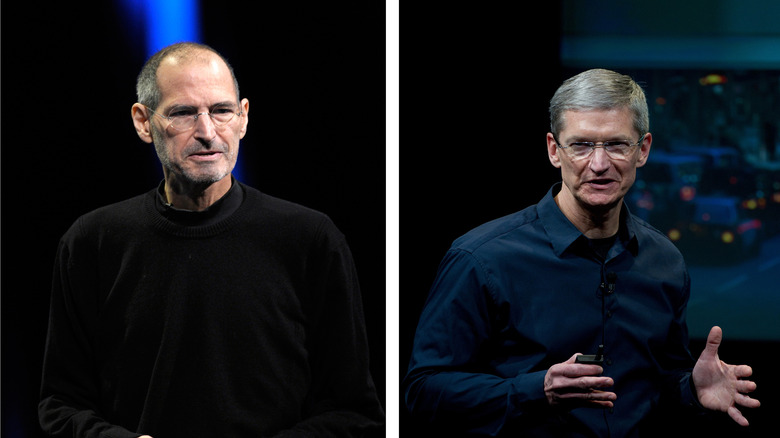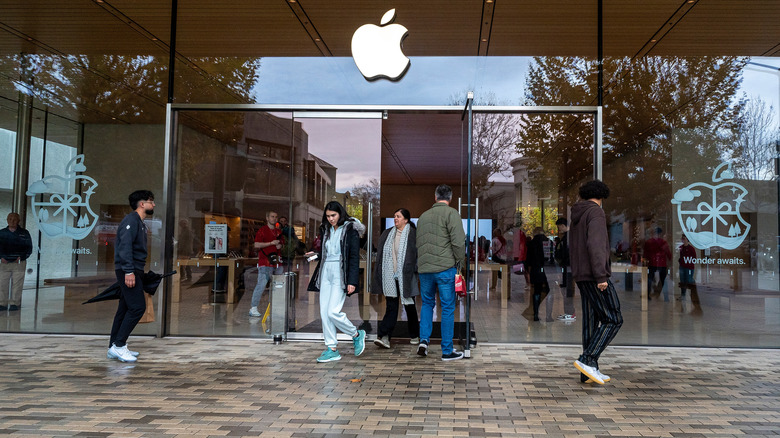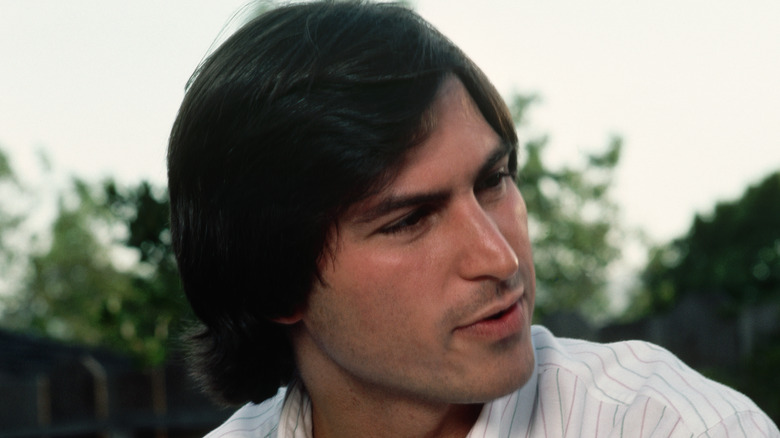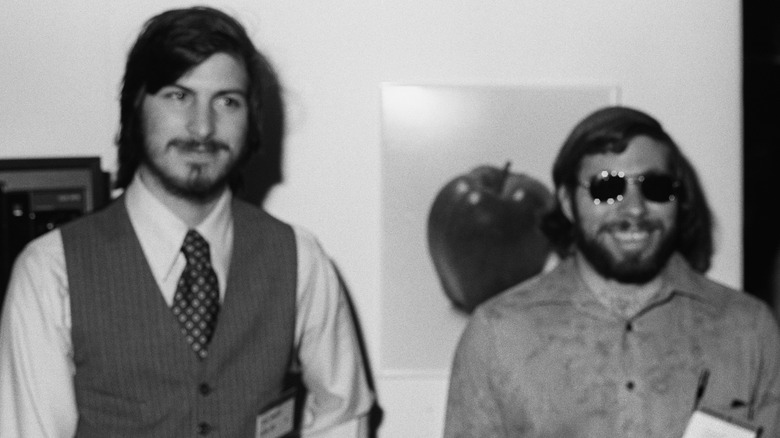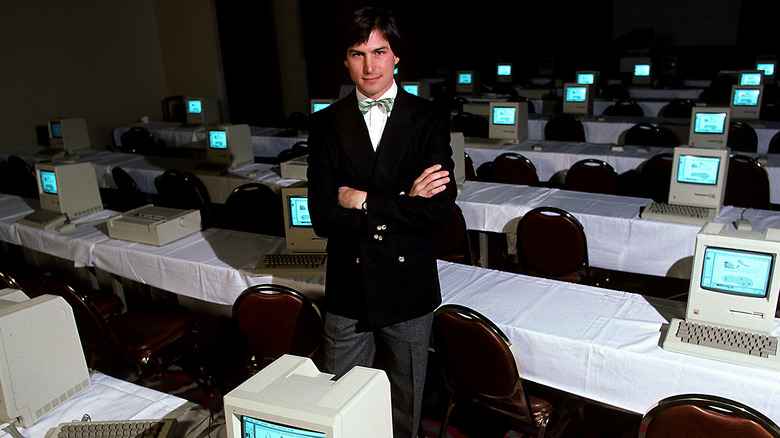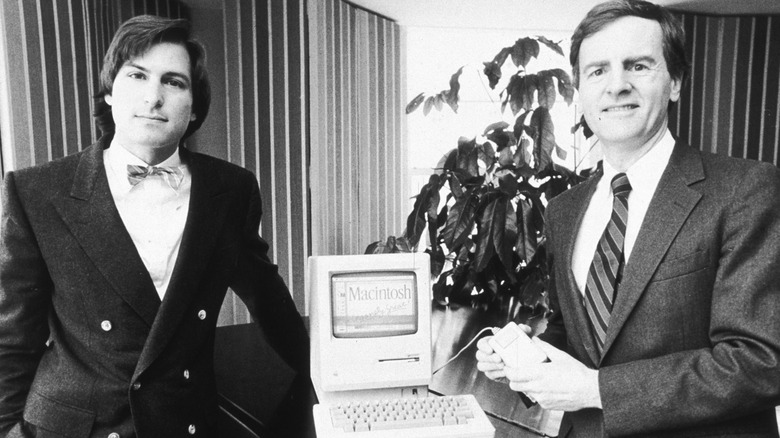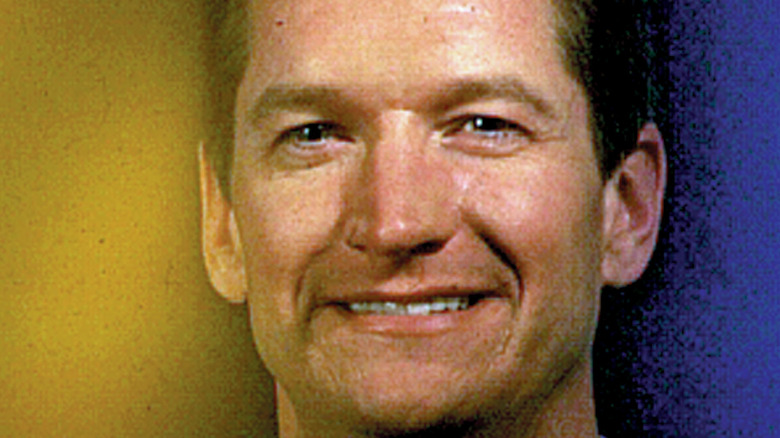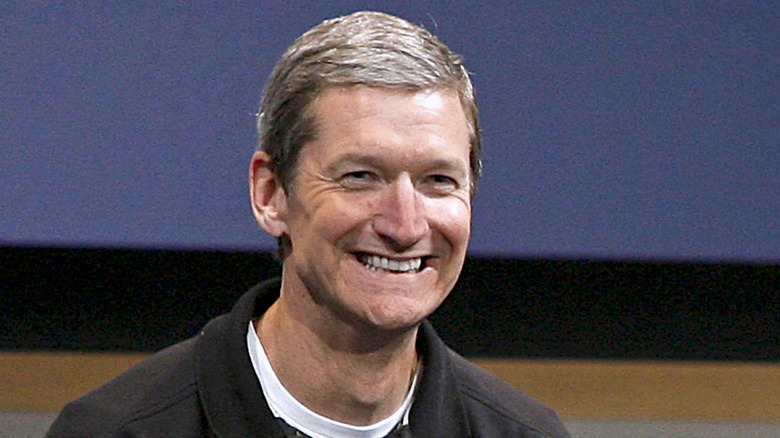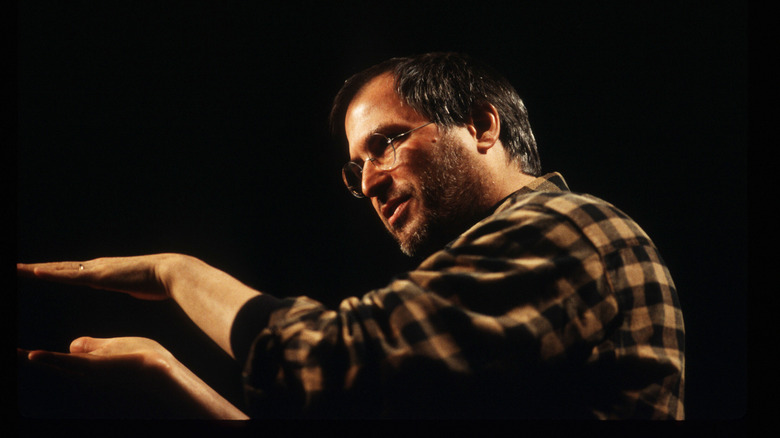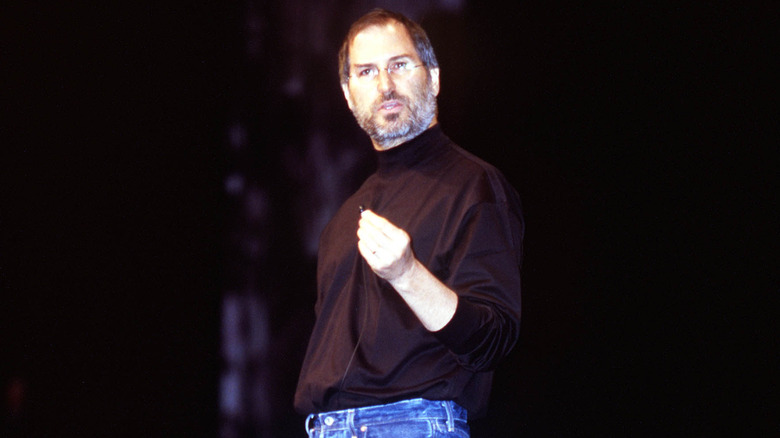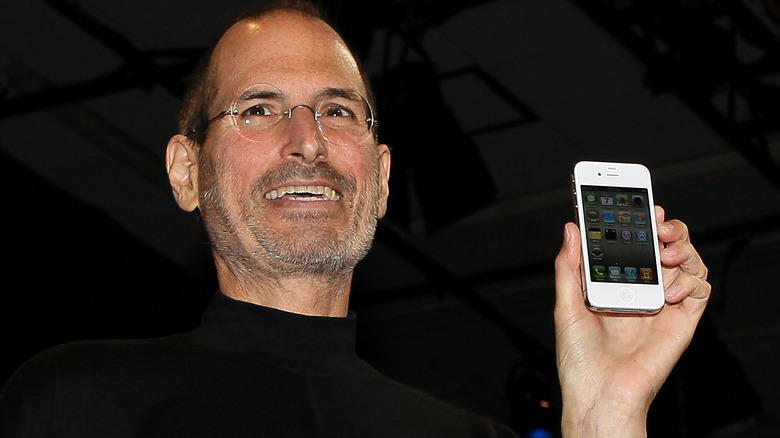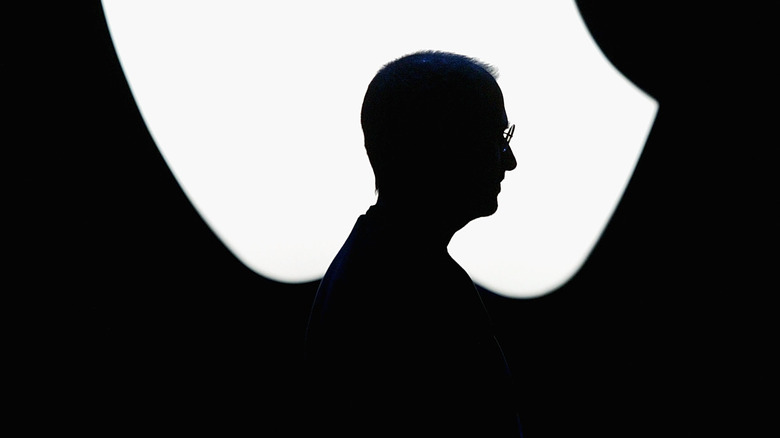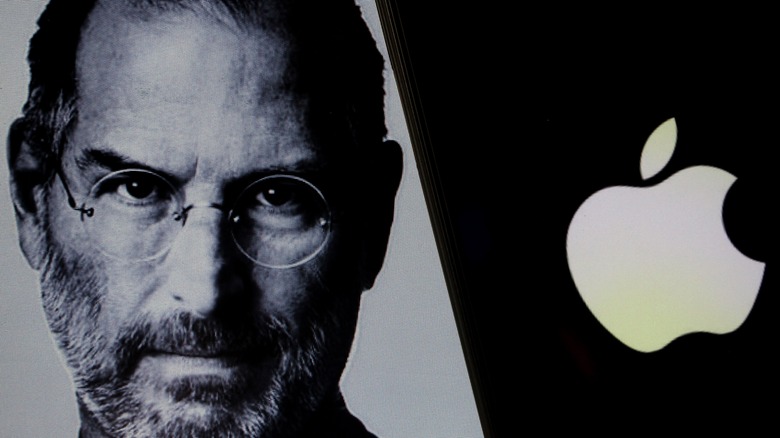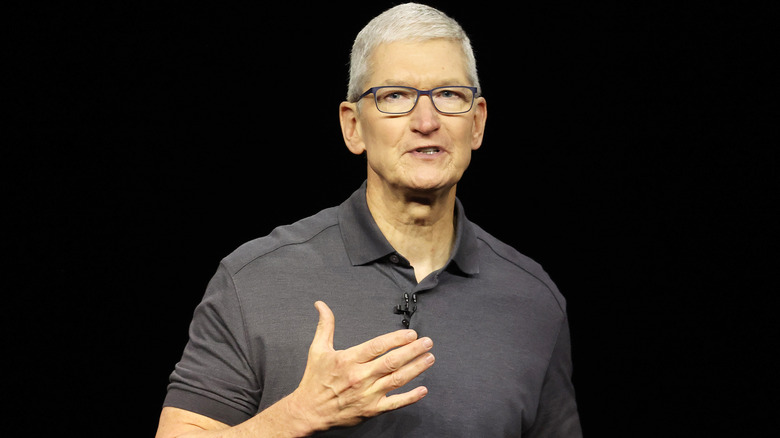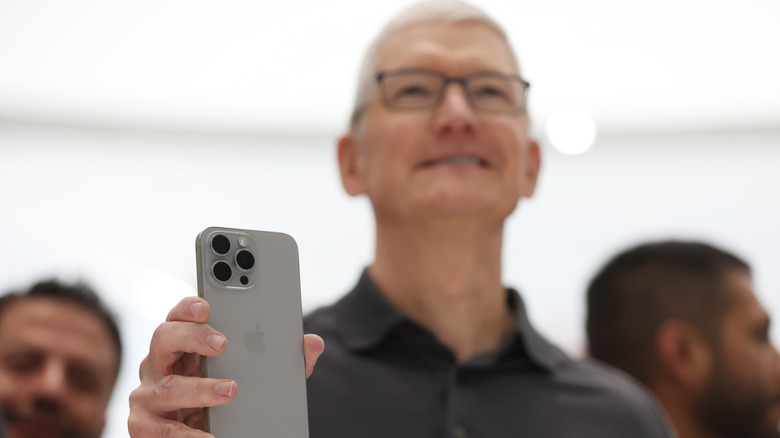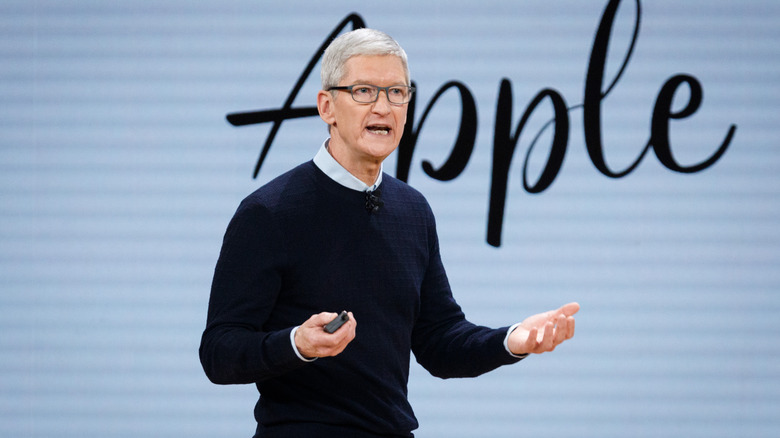Tim Cook Vs. Steve Jobs: A Detailed Comparison Of Their Leadership Styles
It may seem crazy initially, but when you hear the word "apple," there's a close to equal chance of your mind first going to the fruit, or perhaps to the company that bears it as its logo and name. Apple has led the field in smartphone innovation for nearly twenty years, and later this month, it will have been 40 years since the release of the original Apple Macintosh began to reshape computing as we know it.
Throughout the long life span of Apple, two names ring most prominently within the company's storied history: Steve Jobs and Tim Cook. You may also think of Steve Wozniak, Apple's co-founder, or maybe you'll think of John Sculley, the man who helmed Apple through its darkest time. However, Jobs and Cook are set apart as the two leaders who have overseen Apple at its highest heights. However, you'd be hard-pressed to find two more different men in terms of their style of leadership.
Still, the devil is in the details. Comparing Jobs and Cook isn't as simple as looking at the successes of Apple during either man's time as the company's CEO. Rather, it requires a closer look at both men and the challenges, triumphs, and failures that molded them into the leaders they ultimately became at the helm of Apple.
The biggest company in the world
It's important to step back and reflect on Apple's status before beginning to understand either man. Whether you swear by the entire product line-up, absolutely despise everything the company releases, or maybe lie somewhere in the middle, Apple's reach and influence are undeniable. Apple is the biggest company in the world, with a market cap of nearly three trillion dollars. To put it into an Apple-related analogy, that'd be the equivalent cost of nearly 850 million of the $3,500 Apple Vision Pro the company is set to release this year.
Apple's success over the decades is a meteoric rise that can be easily viewed through the lens of the two men who have managed the company through its biggest successes.
Steve Jobs' early days
Before the world knew him as a tech visionary, Steve Jobs' journey commenced with humble beginnings. Born on February 24, 1955 in San Francisco and adopted by Paul and Clara Jobs, Steve's early years were marked by curiosity and a rebellious nature that could sometimes stand in the way of his academic life. Jobs' fascination with electronics and technology in particular manifested during his adolescence, but this also came with a heavy interest in the arts from a young age as well. These two qualities, the clashing of art and technology, would go on to influence much of Jobs' design philosophy with Apple's products.
His quest for knowledge led him to many interesting ventures in his adolescence. Most interestingly, Jobs called HP co-founder Bill Hewlett when he was just twelve years old to ask for spare electronics, a call which resulted in him getting a summer internship at HP. After finishing up high school, Jobs briefly attended the private Reed College but would go on to drop out. His reasoning for dropping out came down to him finding the school overpriced, especially for his working-class parents.
"Here I was spending all of the money my parents had saved their entire life," Jobs said in his 2005 commencement speech at Stanford. "So I decided to drop out and trust that it would all work out okay. It was pretty scary at the time, but looking back it was one of the best decisions I ever made." Jobs went on to describe how he continued dropping in on courses around the school for another year and a half, before finally packing up.
Jobs and Wozniak
Long before his days at Reed College, Jobs had already made one of the most important friends he would ever make: Steve Wozniak. The synergy between Jobs and Wozniak, two innovators with complementary skills, laid the groundwork for one of the most iconic partnerships in the history of technology. Their friendship blossomed at Homestead High School in Cupertino, California, where a shared passion for electronics and a rebellious spirit brought them together.
Wozniak's technical prowess and Jobs' entrepreneurial vision formed a symbiotic relationship that would prove instrumental in their future endeavors. The duo's first collaborative project was the "blue box," a device crafted by Wozniak that could manipulate the phone system for free long-distance calls. Jobs saw the immediate potential in selling such a device and that's just what they did until they were nearly caught by the police.
However, it was in 1975 that Wozniak made his most important invention, the Apple I. After showing it to Jobs, the pair made history by co-founding Apple Computer, Inc. in the Jobs family garage. With the introduction of the Apple I the seeds of a revolution were sown. Jobs, recognizing the potential beyond hobbyist circles, spearheaded efforts to gain capital for a larger scale of manufacturing.
Things would truly take a turn for Apple in 1977 when Mike Markkula was persuaded to co-sign a bank loan for $250,000 (amount) for Apple. For his efforts, Markkula became a one-third owner of Apple. With the money from Markkula's help and additional investments, Jobs and Wozniak could roll out the Apple II. The Apple II, unlike its predecessor, was a machine built and ready to run out of the box. This concept in particular was important to Jobs.
Apple's early success
The dawn of the 1980s marked the era of Apple's initial rise in popularity, and unofficially at the helm was the charismatic and visionary leadership of Steve Jobs. The company, propelled by the success of the Apple II, rapidly emerged as a trailblazer in the burgeoning personal computer market. However, the Apple III and the Apple Lisa failed to meet the standard of the Apple II.
In 1984, Apple's success still wasn't entirely set to turn around, but it nevertheless made an impact on the future of computing with the introduction of the Macintosh. Its groundbreaking graphical user interface showcased Jobs' commitment to pushing technological boundaries and making computing more accessible to the general public. It also showcased Jobs' commitment to the Art side of computing. His unparalleled ability to blend form with function became evident in Apple's products, emphasizing design aesthetics without compromising performance.
The Apple Macintosh introduced the world to many things that are commonplace in modern computing, such as having a GUI and using a mouse. One major contribution on the part of Jobs was the inclusion of multiple fonts. During his in-between time after dropping out of Reed College, Jobs sat in on a calligraphy course that resonated with him when designing the Macintosh. Although a seemingly trivial detail, it marked the beginning of what is now a very standard practice on computers.
Jobs out
The latter half of the 1980s saw a tumultuous period in Apple's history, marked by internal power struggles and a strained relationship between Steve Jobs and then-CEO John Sculley. Jobs had lured Sculley into Apple, away from Pepsi, in 1983. Jobs famously coaxed Sculley into taking the position with the quip, "Do you want to spend the rest of your life selling sugar water, or do you want a chance to change the world?"
Despite the innovations of the Macintosh, it wasn't quite the killer product Apple needed to get a leg up on IBM at the time. Jobs, who had very clearly gone all in on the Macintosh, was moved to "New Product Development," an effectively meaningless position. In response, Jobs attempted to stage a boardroom coup on Sculley, but his plans leaked to the board, and he ultimately ended up resigning from Apple.
Jobs' departure from Apple marked the end of an era. The visionary who had played a crucial role in shaping Apple's identity had unceremoniously left the company. Apple faced a period of uncertainty as it moved onward without its co-founder. This turn of events, while contentious at the time and still to this day, would eventually set the stage for Jobs' transformative journey outside of Apple.
Tim Cook's early days
On November 1, 1960, Tim Cook was born in Alabama. Unlike Jobs, Cook grew up in a modest environment, his early years shaped by the values of hard work and perseverance instilled by his parents, Geraldine and Donald Cook, a pharmacy worker and a shipyard worker respectively. Whereas Jobs had grown up in the epicenter of what would become Silicon Valley, Cook grew up in the small town of Robertsdale, Alabama.
His upbringing in the South during the Civil Rights Era had a profound effect on the future Apple CEO. Cook has previously recalled such harrowing incidents as witnessing a group of Klansmen burning a cross in the yard of a black family. Kerry Kennedy, the daughter of Robert F. Kennedy, told The Washington Post, "I have to believe that growing up in Alabama, during the 1960s and witnessing what he did, especially as someone who is gay, he understood the dangers of remaining silent."
Cook's academic excellence became evident early on, with him being a quiet, top student, quite the opposite of Steve Jobs. After high school, he would go on to earn a bachelor's degree in industrial engineering from Auburn University in 1982.
Cook at IBM and Compaq
After getting his degree, Cook was hired on at IBM in 1982, amid their rivalry with Apple. Cook's role within the company's pipeline management marked the initiation of his deep dive into the intricacies of supply chain management and operations. His tenure at IBM provided invaluable insights into the complexities of a large-scale tech corporation and equipped him with the skills that would later define his leadership style. While there, he got to see firsthand the just-in-time manufacturing model. The just-in-time manufacturing model saw IBM ordering parts only when needed, which kept costs down both monetarily and in terms of time as well.
Cook eventually climbed the ranks at IBM to become their director of North American fulfillment. While at IBM, Cook earned his MBA from Duke University in 1988. In 1994, Cook left IBM and joined Intelligent Electronics as the COO of their computer reseller division. Cook left the position in 1997 for a new chapter in his career at Compaq as Vice President of Corporate Materials. At Compaq, he continued to hone his skills in supply chain management and played a key role in streamlining the company's operations. His ability to navigate the intricate world of technology, coupled with a keen eye for operational excellence, caught the attention of many industry observers.
Jobs' time away from Apple
After he departed from Apple in 1985, Jobs' journey took a divergent path, leading him to explore new ventures and industries. Unfettered by the constraints of the corporate structure, Jobs embarked on a period of self-discovery and innovation that would ultimately redefine his role in the tech world.
One of Jobs' initial pursuits was the founding of NeXT Computer, a company aimed at producing high-end workstations for the education and business sectors. NeXT was not merely a hardware venture; it also delved into software development, creating the NeXTSTEP operating system. Although NeXT faced challenges in the competitive computer market, it became a crucial chapter in Jobs' narrative, setting the stage for future collaborations and innovations.
Also during his time away from Apple, Jobs invested in The Graphics Group, which later evolved into Pixar Animation Studios. Under his guidance, Pixar became a pioneering force in computer animation, producing groundbreaking films such as "Toy Story." The success of Pixar not only solidified Jobs' prowess as a visionary but also positioned him as a major player in the entertainment industry.
As the 1990s unfolded, Apple faced its share of challenges, prompting the company to acquire NeXT in the final days of 1996. This move would prove to be pivotal, as it marked Jobs' return to the company he co-founded, setting the stage for a remarkable second act that would redefine Apple's trajectory and secure Jobs' legacy as one of the greatest visionaries in the tech industry.
Jobs' return, Cook's entrance
By 1997, Jobs had taken the reins as interim CEO, and the process of rejuvenating Apple had begun. His visionary approach and uncompromising standards became evident in the "Think Different" campaign, which not only revitalized Apple's brand but also set the stage for its resurgence as an industry leader.
In the wake of Jobs' return, he quickly sought to simplify what had become a very bloated product lineup for Apple. To do so would require heavy logistical lifting. Luckily for Jobs, there was a man in the tech world making waves for his supply chain efficiency. There was just one issue: his position as the Vice President of Corporate Materials at Compaq, which at the time was a much more secure and lucrative job than working for Apple.
Cook agreed to meet Jobs for an interview, where Jobs laid out his plans for Apple and their next product. Against the advice of his friends, Cook took the job and was hired on as Senior Vice President for Worldwide Operations. Cook brought a wealth of experience in supply chain management and operational efficiency. His appointment reflected Jobs' strategic vision for ensuring the company's operational prowess.
Cook's impact was swift and significant. He streamlined Apple's supply chain, reducing inventory levels and introducing cost-effective manufacturing processes. This focus on efficiency played a pivotal role in Apple's turnaround, setting the stage for innovation and financial success.
Cook, the logistical wizard who could almost magically fix Apple's supply chain issue, came in at the perfect time to facilitate the launch of the next big product for Apple. Jobs, the creative mind that was stubborn to a tee, had perfected his vision for the Macintosh nearly 20 years prior in the form of the iMac.
Jobs' Reality Distortion Field
Jobs was renowned for his ability to create what became known as the "Reality Distortion Field" (RDF). Coined by Apple employees to describe Jobs' charismatic influence, the RDF encapsulated his uncanny capacity to inspire, persuade, and drive teams to achieve seemingly impossible feats. Though this unwavering self-belief could be beneficial, it could also eventually meet reality.
Jobs' RDF emanated from his unwavering self-confidence, persuasive communication skills, and a compelling vision for the future. Jobs, above many other things, was a salesman. This is evident from viewing his many Apple keynote speeches, none more famous than his iPhone keynote in 2007.
While Jobs' RDF was a potent force in propelling Apple to new heights, it also came with challenges. The intense pressure and relentless pursuit of perfection sometimes strained relationships, and the high expectations set by Jobs were not always easy to meet. Employees of Apple were not shy to share that failing to meet the steadfast goals set by Jobs could result in heavy anger and disappointment from the CEO.
Perfection and simplicity
At the core of Steve Jobs' leadership philosophy during his tenure at Apple were two intertwined principles: perfection and simplicity. Jobs was not just a creative visionary; he was a perfectionist who believed in crafting products that seamlessly merged cutting-edge technology with elegant design.
The pursuit of perfection was manifested in every facet of Apple's products. From the hardware to the software, Jobs demanded excellence. He was known to iterate relentlessly until a product met his exacting standards. This commitment to perfection was not driven solely by technical specifications but also by a deep-seated belief that users deserved the best possible experience in addition to viewing Apple's products as art.
Simplicity, according to Jobs, was the ultimate sophistication. He championed the idea that technology should be accessible to everyone, and complexity was a barrier to that accessibility. Apple products, under Jobs' leadership, were characterized by their intuitive interfaces, minimalist design, and user-friendly functionality. The removal of unnecessary complexity became a hallmark of Apple's approach, allowing users to engage with technology effortlessly.
Jobs' obsession with simplicity extended beyond the products themselves; it permeated Apple's marketing, packaging, and retail experience. The clean lines of Apple stores, the elegant packaging of its products, and the iconic design of advertisements — all reflected Jobs' commitment to simplicity as a guiding principle.
These values were not just about aesthetics; they were about creating an emotional connection with users. The simplicity of Apple products was meant to enhance the user experience, making technology more approachable and, in Jobs' vision, a seamless part of everyday life. The enduring legacy of perfection and simplicity continues to shape Apple's design philosophy long after Jobs' leadership, underscoring the profound impact of these principles on the tech industry as a whole.
Jobs' health and Cook's rise
As Steve Jobs propelled Apple to unprecedented heights, his personal journey took a harrowing turn. In 2003, Jobs was diagnosed with a rare form of pancreatic cancer, which sparked concerns about his health and the future of Apple. Jobs continued to lead Apple through a series of triumphs, including the launches of iconic Apple devices like the iPhone and iPad.
However, the toll on Jobs' health became increasingly apparent, leading to his temporary leaves of absence in 2004 and 2009. It was during these periods that the then-Chief Operating Officer Cook assumed a more prominent role in managing day-to-day operations. Cook's adept handling of the company during Jobs' medical leaves demonstrated his leadership capabilities and operational prowess.
In August 2011, Steve Jobs resigned as Apple's CEO, citing his inability to fulfill the duties of the position due to his health. The mantle of leadership was officially passed to Tim Cook, who became Apple's new CEO. Jobs' departure marked the end of an era, and the tech industry watched with anticipation to see how Cook would steer the ship in the absence of the visionary co-founder.
Jobs' health continued to deteriorate, and he succumbed to complications from pancreatic cancer on October 5, 2011. His passing marked the end of a chapter at Apple but left an enduring legacy that would shape the company's future.
Early challenges for Cook
As Cook assumed the role of Apple's CEO in 2011, he inherited a company that had reached unprecedented heights under Steve Jobs but faced challenges on multiple fronts. One of the early and notable challenges was internal strife, particularly the dynamic between Cook and Scott Forstall, Senior Vice President of iOS Software.
Forstall, a key figure in the development of iOS and the iconic iPhone, had a reputation for being a brilliant, albeit polarizing figure within Apple. His confrontational management style and alleged clashes with other executives, including Cook, became a source of internal tension. Cook, known for his calm and collaborative approach, sought to foster a more harmonious working environment.
The climax of this internal strife came in 2012 when Apple launched Apple Maps to much trouble. The company released a public letter of apology, which Forstall refused to sign onto, an action that ultimately led to him being fired by Cook. This decisive action led to what remains the biggest shakeup in iOS history, the launch of iOS 7.
Above all, this marked Cook holding fast to one of the last guiding pieces of advice Jobs had left him and all of Apple with. Cook shared this advice at Jobs' memorial service. "Among his last advice he had for me, and for all of you, was to never ask what he would do," Cook said. "Just do what's right."
Efficiency and individuality
Tim Cook's leadership at Apple has been defined by two key values: efficiency and individuality. Unlike his predecessor, Cook is known for his methodical and data-driven approach.
Cook's background in supply chain management, honed during his tenure at companies like IBM and Compaq, has left an indelible mark on Apple's operational efficiency. Under Cook's leadership, Apple's supply chain became a model for the industry, minimizing inventory levels, reducing lead times, and ensuring a smooth production process. This emphasis on efficiency not only enhanced cost-effectiveness but also allowed Apple to respond swiftly to market demands.
Beyond the supply chain, Cook extended his commitment to efficiency to various aspects of the company. The consolidation of product lines and the removal of redundant features from Apple's software also reflected Cook's dedication to maximizing efficiency without compromising quality. This pairs away nicely with a shift in the thinking of what kinds of services Apple could offer, which has led to the introduction of subscriptions such as Apple Music and Apple Fitness+.
While efficiency remains a cornerstone of Cook's leadership, he also places a strong emphasis on individuality and in turn humanity, through increasing Apple's charitable giving. Cook's Apple has also embraced individuality in terms of corporate culture. The company encourages employees to think creatively and express their unique perspectives. Initiatives such as the "Everyone Can Code" help to foster the future of tech companies by bringing coding into the classroom.
The delicate balance between efficiency and individuality forms the crux of Cook's leadership philosophy. By marrying operational excellence with a commitment to innovation and individual expression, Cook has steered Apple through an era of continued success, maintaining its status as a tech industry leader while embracing the diverse needs and preferences of its global user base.
The future
Under Cook's stewardship, Apple has continued to thrive, cementing its position as a global technology giant. Still, the spirit of Jobs lives within every Apple product to this day. What the future of the company holds is a mystery.
"We're a company that believes in working on succession plans, and so we have very detailed succession plans," Cook said in an appearance on Dua Lipa: At Your Service. "My job is to prepare several people for the ability to succeed. I really want the person to come from within Apple, the next CEO." Although it's unlikely to be known anytime soon who will take the reigns of Apple after Cook, what is clear is that they will have two gargantuan pairs of shoes to fill.
